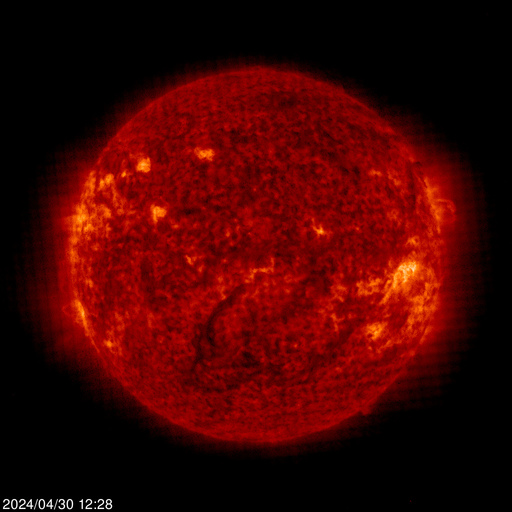SIDC Ursigram
3-day-forecast of solar and geomagnetic activity.| Source | SIDC (RWC-Belgium) |
| Frequency | Daily |
| Format | Encoded data (ISES) |
| Mail header | SIDC Ursigram |
| SIDC code | meu |
Archive
Latest issue
:Issued: 2025 Jul 01 1231 UTC :Product: documentation at http://www.sidc.be/products/meu #--------------------------------------------------------------------# # DAILY BULLETIN ON SOLAR AND GEOMAGNETIC ACTIVITY from the SIDC # # (RWC Belgium) # #--------------------------------------------------------------------# SIDC URSIGRAM 50701 SIDC SOLAR BULLETIN 01 Jul 2025, 1230UT SIDC FORECAST SOLAR FLARES : C-class flares expected, (probability >=50%) GEOMAGNETISM : Minor storm expected (A>=30 or K=5) SOLAR PROTONS : Quiet PREDICTIONS FOR 01 Jul 2025 10CM FLUX: 130 / AP: 008 PREDICTIONS FOR 02 Jul 2025 10CM FLUX: 128 / AP: 043 PREDICTIONS FOR 03 Jul 2025 10CM FLUX: 125 / AP: 031 Solar Active Regions and flaring: Solar flaring activity over the past 24 hours was low, with several C-class flares recorded. The largest flare was a C1.9 flare, peaking at 18:34 UTC on June 30, associated with SIDC Sunspot Group 543 (NOAA Active Region 4130; magnetic type beta). There are currently thirteen numbered active regions on the visible solar disk. SIDC Sunspot Group 541 (NOAA Active Region 4129) is currently the most magnetically complex region, with a beta-gamma configuration, but produced only low-level C-class flaring. SIDC Sunspot Group 543 (NOAA Active Region 4130) and SIDC Sunspot Group 513 have rotated onto the disk from the southeast limb. SIDC Sunspot Group 527 (NOAA Active Region 4118) is expected to rotate over the west limb in the coming hours. Two new active regions emerged in the southwest and northwest quadrants during the period, numbered SIDC Sunspot Groups 544(beta) and 545(beta), respectively, but did not produce any significant flaring activity. Low-level flaring activity was also produced by SIDC Sunspot Group 537 (NOAA Active Region 4126; beta). The remaining active regions are relatively simple (magnetic type alpha or beta) and did not produce any significant flaring activity. Solar flaring activity is expected to be low over the next 24 hours, with C-class flares very likely and a chance for M-class flares. Coronal mass ejections: No Earth-directed CMEs were observed in the available coronagraphic imagery over the past 24 hours. Solar wind: Over the past 24 hours, solar wind parameters (ACE and DSCOVR) reflected the waning influence of high-speed streams (HSSs) from SIDC Coronal Hole 116 (negative polarity). The solar wind speed ranged between 450 km/s and 550 km/s. The interplanetary magnetic field remained below 6 nT, and its southward component fluctuated between -6 nT and 6 nT. Slow solar wind conditions are expected to prevail over the next days, with a chance of a weak enhancement from July 02 due to the possible arrival of an ICME associated with a partial halo CME (SIDC CME 523), observed lifting from the Sun on June 28, and the anticipated high-speed stream arrival from the recurrent negative polarity coronal hole (SIDC Coronal Hole 111). Geomagnetism: Geomagnetic conditions were at quiet to unsettled levels globally (NOAA Kp: 2 to 3). Locally, over Belgium, active conditions were reached between 18:00 and 21:00 UTC on June 30 (K-Bel: 4). Geomagnetic conditions are expected to remain at quiet to unsettled levels, with a chance of increasing to active conditions and isolated minor or moderate storm periods from July 02, due to the possible arrival of an ICME associated with a partial halo CME (SIDC CME 523) observed lifting from the Sun on June 28, and the expected high-speed stream arrival from the recurrent negative polarity coronal hole (SIDC Coronal Hole 111). Proton flux levels: The greater than 10 MeV GOES proton flux was below the threshold level over the past 24 hours and is expected to remain so for the next 24 hours. Electron fluxes at GEO: The greater than 2 MeV electron flux, as measured by GOES-18 and GOES-19, exceeded the 1000 pfu threshold over the past 24 hours. The greater than 2 MeV electron flux is expected to exceed this threshold again in the coming days. The 24-hour electron fluence was at moderate to high levels and is expected to remain at these levels over the next 24 hours.
Zdroj : SIDC Ursigram |
Předpověď sluneční aktivity pro období : June 27 - July 03, 2025
Zdroj : http://www.asu.cas.cz/~sunwatch |
Poslední fotografie ze SOHO / SDO:
Různé barvy snímků prozrazují odlišné vlnové délky - každá
vlnová délka je vyzařována plynem o určité teplotě: oranžová: 80 000 °C,
modrá: 1 000 000 °C, zelená: 1 500 000 °C, hnědá: 2 500 000 °C.










